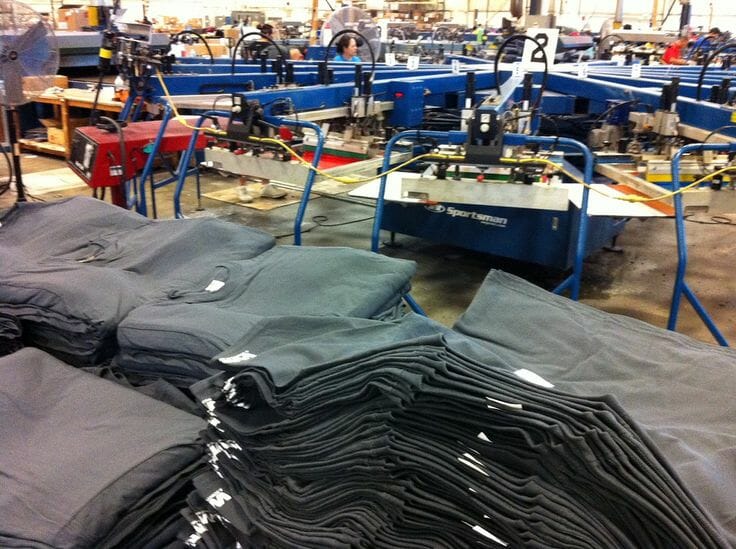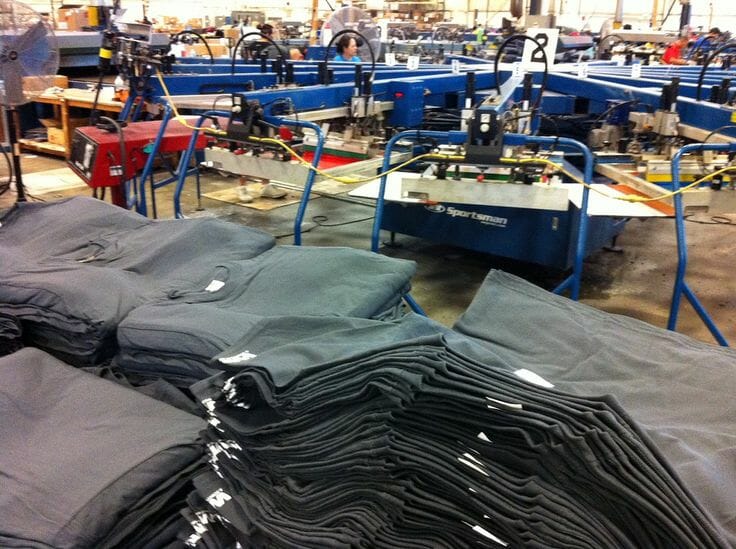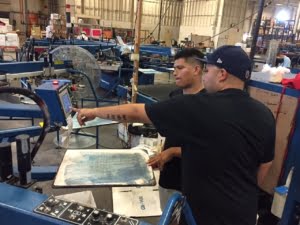It just happened, and you still can’t believe it! You hung up the phone with your client and they let you know that you won that gigantic order. Congratulations! It’s going to be the biggest order your shop has ever printed, and along with that the biggest payday. Then it hits you. It’s also the biggest risk you’ve taken; and the biggest liability if something goes wrong. Oh crap. The first bead of sweat starts rolling down your forehead as you begin to panic. How are you going to pull it off?
Luckily for you, other shops have printed these huge orders before. For some, like mine, it’s an everyday occurrence. Below are some tips for making sure that your big payday happens without a challenge.
Produce a sample and get it approved. The big order probably has a time deadline, so it’s imperative that a sample order is created and sent to the client immediately. Overnight it. Print it on the press you are going to run the job, with the crew that will be printing the order. Don’t sample it manually, and then try to replicate it on your auto in a few days, as that sometimes can be a struggle to match the final print. Get their approval in writing. If the order has multiple locations, and not all of them are approved try to get the job started by asking if one or more of the locations can be approved so you can get started printing. For big orders, most shops throw the sample in for free as this is more about an insurance policy than getting paid to print a sample. Make sure that more than one person in your shop sees the sample, and everyone approves that it is the best you can print. Get someone in the art department to review at the very least, as they have a good eye for color matching and detail. If you send a sample that is less than perfect, your client will think the entire order will be printed like that. Don’t risk the customer confidence earthquake, triple check that the sample is exactly what they wanted. I can’t stress this enough. You want to send perfection and when the box opens for the client to review, angels sing.
Check your ink stock. Want to see a shop owner go ballistic? Run out of ink during a long print run. You know what you need for this big order. Check your stock levels and make sure you have enough. If you are not sure, place an order. Ink isn’t produce from the grocery store; it won’t go bad if it sits on the shelf. Also, maybe you are used to ordering only ink by the gallon. You can also order it in five gallon buckets, thirty and fifty-five gallon drums. Every time you go up in size, the price per gallon drops a bit. It is the same ink, just a lower price. For a big run, you might consider trying out a larger ink container order. If you are mixing your own ink colors, make sure you mix a little more than you think you need. There’s nothing worse than not being able to match a color during long print run for some reason. The first shirt has to look like the last shirt. Color matching is crucial.
Inventory shipping concerns. For large orders, the inventory will ship to you in a semi-truck. On skids, depending on the shirt sizes for the order, they can fit about 50,000 to 55,000 shirts on a truck. Floor loaded, meaning the trailer is stacked floor to ceiling with t-shirt boxes, they can fit over 70,000. Be sure you ask how the inventory is coming in for the order as you need to prepare. Don’t get caught unprepared when the truck backs up and you are not ready. There is a big difference between unloading a truck with inventory on skids with a forklift or pallet jack, and unloading a floor loaded trailer by hand. When unloading, be sure to segregate the boxes by size on different pallets as this will help you check them in later. The more organized you keep your inventory the better. Think and plan your actions.
Inventory shipping concerns, part two. It’s been my experience over the years that the information regarding the inventory freight will either be wrong or non-existent. Truck drivers seem to have a schedule all of their own. If the truck is supposed to show up on a Tuesday afternoon, it could be parked in your lot on Monday or even 4:30 in the morning on Tuesday. Or Wednesday. Early is better than later, but be prepared. Just because the truck is late, that doesn’t mean you might get more time to produce the order. Have your staff on alert and a plan in place for when the truck does arrive. This means some space created for the inventory to call home, empty skids ready to load, and paperwork accessible to use during check-in. Assign tasks, and double count everything. Make sure you crack open every box, and double check size and color. I’ve seen more than one job have the wrong shirts delivered, or missing one size completely, and this is something you want to discover immediately…not at the press a few days later when you have a deadline approaching. If you do have any inventory issues get on them early and start working the challenge towards a resolution. All is not lost, as you can’t print all of the shirts at once. Verify what you do have against the order, and start on whatever size is correct.
Make the job easy. Handling big jobs is better if you stay prepared and double check everything as the job is being produced. Have a second set of screens burned in case something happens on press, so you can quickly swap one out. Make sure you have a support team in place that can keep ink in the screens, and shirts loaded on the carts or table so the loader doesn’t have to stop. Every once and awhile trade out loaders so that there is good quality in loading and your staff stays sharp. Doing the same task repetitively, without a change in scenery can sometimes lead to a lack of focus. Give a puller or catcher some experience running the press on a longer job, and have the regular press operator in the puller position mentoring them. This keeps your crew fresh, focused and engaged in the job. For press speed, nice and comfortable is better than teetering on the edge of too fast. If the loader is skipping boards as they can’t keep up, slow it down a bit to ensure quality. Keep a production log, and record the total number of impressions produced per shift as well as any misprints. This is extremely valuable information to use later for estimating for other potential large orders, so make sure your crew takes it seriously.
Tricks to increase speed. When printing longer runs on dark colors, after a bit your platens will heat up due to increased exposure from the flash cure units. You can back down the dwell time under the flash units, as the heated boards will help with this process. Also, look to make sure that your squeegee stroke length is tuned into the actual size of the image. You don’t need to have everything travel several inches past the image, as that just slows down the printing. Adjust on press, as this small amount of time can really add up over a longer print run. As mentioned above, watch your press speed and load at a comfortable pace. You may think cranking it up, and running the press so fast that you occasionally skip boards might be worth it; but what really happens is that you’ll have more misprints and skipping boards at a faster rate doesn’t add up to more impressions at the end of the shift. Not stopping is the key. Have support crew add extra ink or load your shirts on the table or cart, as this will increase your speed considerably. Remember, every time you stop the press you are losing about 15 shirts an hour.
Keep quality a priority. Quality prints are important, especially on larger orders. You don’t want to run the risk of your client rejecting or complaining about the order, so make sure your management staff keeps a keen eye on the job. Hang up a printed sample and have your catcher compare your sample with one off the belt occasionally. They should match. Watch your placement, as you can have a great looking image but it could be printed crooked or off-center. Train your staff to look for key items with the print and know what to do to correct any challenges. Most shops use a 2% per impression defect ratio, but for large orders it is common in the industry that this is reduced to 1%. If you are doing your job right, you won’t even come close to that. Make sure that your “recipe” for printing the job is recorded, so that you know how to replicate the job if there is a reorder later. Record all mesh counts, Pantone colors in sequence, squeegee durometer, placement (3” down from the collar for example) or any special tips for running the job.
Contracting part of the order. Some orders can come in that are so huge it will be impossible for you to meet the deadline. One way to be able to take that order is to consider either farming out a portion, or even the entire job, to another printer. This is tricky business, as you need to partner with someone that you can trust, has room on their schedule, and can produce the job and meet both quality and timing considerations. Usually this is lined up well in advance, and not when the job is underway. If you go this route, be absolutely clear on your expectations on the order with over-communicated instructions. Make sure an approved sample is provided. You may even consider sending them the ink, so all the colors match. During production check in with them frequently for progress updates and to discuss any challenges. Absolutely get the ok from your client if you feel you need it. If you want to play it close to your vest and not disclose you are contracting part or the entire order to another shop, that’s acceptable too. However, at the end of the day you are responsible for the order. If the other shop has a challenge with the order, you are on the hook to make it right. You can’t point fingers. You own it.
Communication. For large orders communication with your staff regarding the expectations and job information is the key to starting out on the right foot. There can’t be any last minute surprises, and it is imperative that all of the details are correct on the work order, art approval form or mock up, and especially shipping dates. Don’t use a padded date as that creates confusion and distrust with your production staff. Use the real date, and as the job progresses have everyone informed as to the status. On the client side, your customer service rep should occasionally send them a note regarding progress and to let them know that the order is on track. Do this before the client asks, as they usually do, and this will generate some goodwill with the client and they will see you as “on top of it” regarding the order.
Intangibles. Huge print runs can affect your other business on your schedule. They will tie up a press (or presses) for days at a time, and may put a strain on other orders in the system. If you don’t have a second shift, or print on weekends you may consider working some OT for this large order just to get it out of the way. Overtime and any other special considerations should have been thought about before accepting the job, but if you get in situation where you need it, always opt for getting the order out. Keep your morale up with your press crews. Bring in pizza, doughnuts, coffee or refreshments. Say “Thank You”, and show your appreciation when your staff starts to show strain. Get in there and help out.
Finishing the job. Get the order prepped for shipping by stacking the skids neatly. Skids should be organized so that they are all one shirt size as much as possible. All boxes should be clearly marked with order information on a label, with the label placed on the box in the same location on every one. Neatness counts. Don’t handwrite anything, use your system and print a label. Once all the boxes are labeled and stacked neatly on skids, wrap each skid with shrink-wrap to secure it. This is important, as the load may shift during travel and you don’t want the shirt skids to fall over or become a problem. Prep your freight load and print a bill of lading for the shipment. If you have to arrange for pick up several days in advance, always state a late afternoon pick up, to give you a time cushion should you need it. The truck is going to show up early usually, so if the load is ready they will gladly accept it so they can get going down the road faster.
Show me the money. For any order in your shop, collecting the payment is imperative to keeping your business running smoothly. When discussing gigantic orders, this can make or break a shop as a ridiculous amount of money can be on the line. Often, these large orders will have the customer purchasing the inventory which is good for the screen printer as that doesn’t tie up a huge amount of cash. If you are ordering the blanks you absolutely need to get a very large deposit before even entering the order in your system. Don’t buy any inventory unless you have a deposit. Imagine the financial nightmare for your shop if this huge order lands on your account receivable list over 90 days out? Avoid that disaster by being ultra-diligent in shoring up the financial end before you start. Get money up front, have signed purchase orders or contracts, run a credit check, and be sure to have several conversations about payments. Also, it’s important that you outline your defect and misprint policy on this order. What percentage is the ratio for the order? Does it have to ship 100% complete? Are extras shirts being ordered with the initial inventory to cover any potential misprints, or is that your responsibility? Every client is different, so don’t assume your policy matches how they think this order will work.
In conclusion, you don’t have to be scared of a monster job if you’ve never handled one before. They are just much larger cousins of the orders you handle every day. The trick for successful production is to stay organized, keep an eye out for trouble, communicate expectations with your staff and your customer, and keep track of progress as you go. You can do it!







2 comments
Jeff Elliott
Great article Marshall.
Jeff Elliott
T-Formation |Embroidery Manager
ph 850.504.6952 | toll free 800.223.7919
EMAIL ME | WEBSITE | FACEBOOK
atkinsontshirt
Thanks Jeff!!